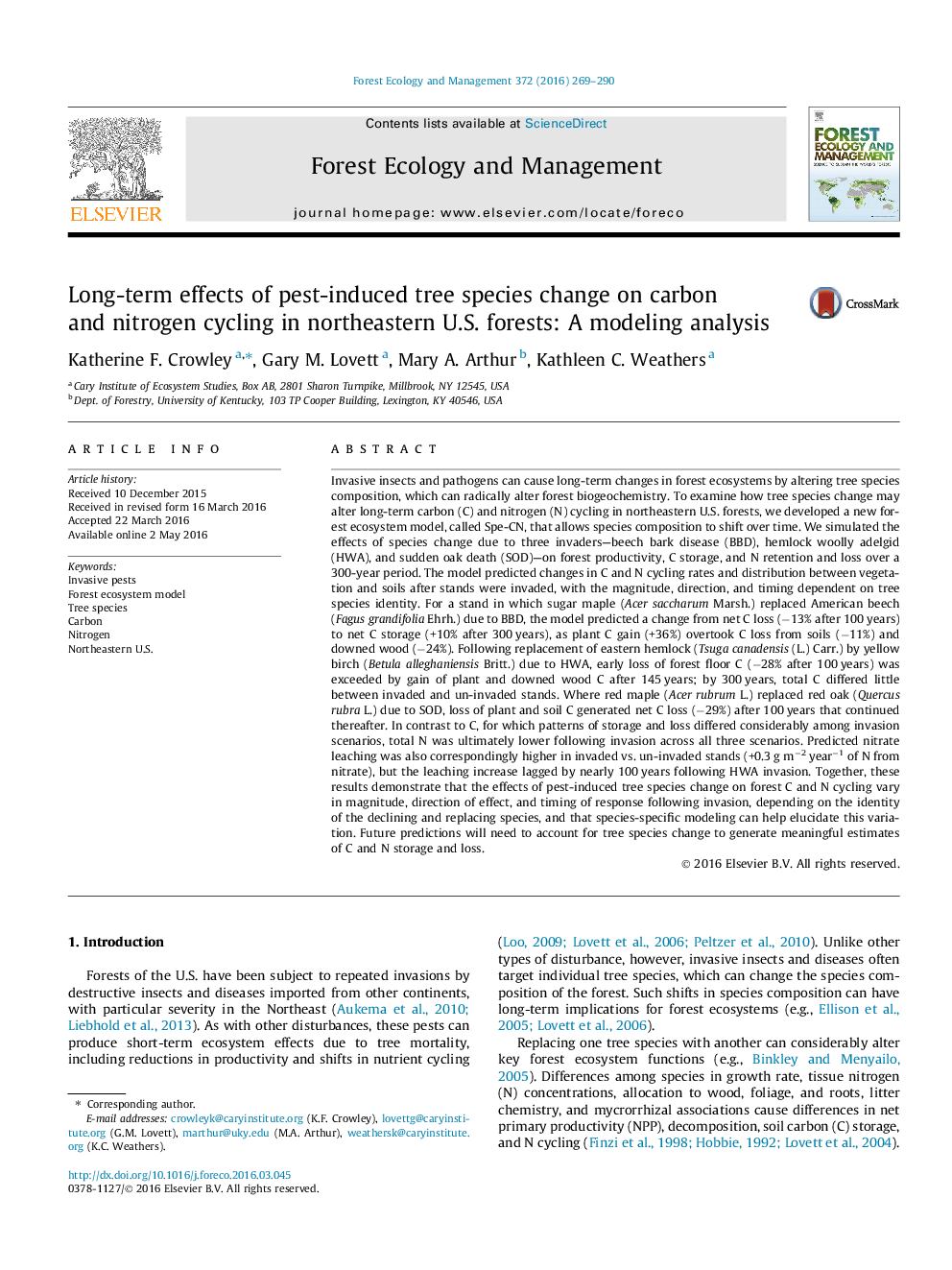| کد مقاله | کد نشریه | سال انتشار | مقاله انگلیسی | نسخه تمام متن |
|---|---|---|---|---|
| 6542313 | 159151 | 2016 | 22 صفحه PDF | دانلود رایگان |
عنوان انگلیسی مقاله ISI
Long-term effects of pest-induced tree species change on carbon and nitrogen cycling in northeastern U.S. forests: A modeling analysis
ترجمه فارسی عنوان
اثرات دراز مدت گونه های درختان ناشی از آفات بر کربن و نیتروژن دوچرخه سواری در جنگل های شمال شرقی ایالات متحده تغییر: تجزیه و تحلیل مدل سازی
دانلود مقاله + سفارش ترجمه
دانلود مقاله ISI انگلیسی
رایگان برای ایرانیان
کلمات کلیدی
موضوعات مرتبط
علوم زیستی و بیوفناوری
علوم کشاورزی و بیولوژیک
بوم شناسی، تکامل، رفتار و سامانه شناسی
چکیده انگلیسی
Invasive insects and pathogens can cause long-term changes in forest ecosystems by altering tree species composition, which can radically alter forest biogeochemistry. To examine how tree species change may alter long-term carbon (C) and nitrogen (N) cycling in northeastern U.S. forests, we developed a new forest ecosystem model, called Spe-CN, that allows species composition to shift over time. We simulated the effects of species change due to three invaders-beech bark disease (BBD), hemlock woolly adelgid (HWA), and sudden oak death (SOD)-on forest productivity, C storage, and N retention and loss over a 300-year period. The model predicted changes in C and N cycling rates and distribution between vegetation and soils after stands were invaded, with the magnitude, direction, and timing dependent on tree species identity. For a stand in which sugar maple (Acer saccharum Marsh.) replaced American beech (Fagus grandifolia Ehrh.) due to BBD, the model predicted a change from net C loss (â13% after 100 years) to net C storage (+10% after 300 years), as plant C gain (+36%) overtook C loss from soils (â11%) and downed wood (â24%). Following replacement of eastern hemlock (Tsuga canadensis (L.) Carr.) by yellow birch (Betula alleghaniensis Britt.) due to HWA, early loss of forest floor C (â28% after 100 years) was exceeded by gain of plant and downed wood C after 145 years; by 300 years, total C differed little between invaded and un-invaded stands. Where red maple (Acer rubrum L.) replaced red oak (Quercus rubra L.) due to SOD, loss of plant and soil C generated net C loss (â29%) after 100 years that continued thereafter. In contrast to C, for which patterns of storage and loss differed considerably among invasion scenarios, total N was ultimately lower following invasion across all three scenarios. Predicted nitrate leaching was also correspondingly higher in invaded vs. un-invaded stands (+0.3 g mâ2 yearâ1 of N from nitrate), but the leaching increase lagged by nearly 100 years following HWA invasion. Together, these results demonstrate that the effects of pest-induced tree species change on forest C and N cycling vary in magnitude, direction of effect, and timing of response following invasion, depending on the identity of the declining and replacing species, and that species-specific modeling can help elucidate this variation. Future predictions will need to account for tree species change to generate meaningful estimates of C and N storage and loss.
ناشر
Database: Elsevier - ScienceDirect (ساینس دایرکت)
Journal: Forest Ecology and Management - Volume 372, 15 July 2016, Pages 269-290
Journal: Forest Ecology and Management - Volume 372, 15 July 2016, Pages 269-290
نویسندگان
Katherine F. Crowley, Gary M. Lovett, Mary A. Arthur, Kathleen C. Weathers,
